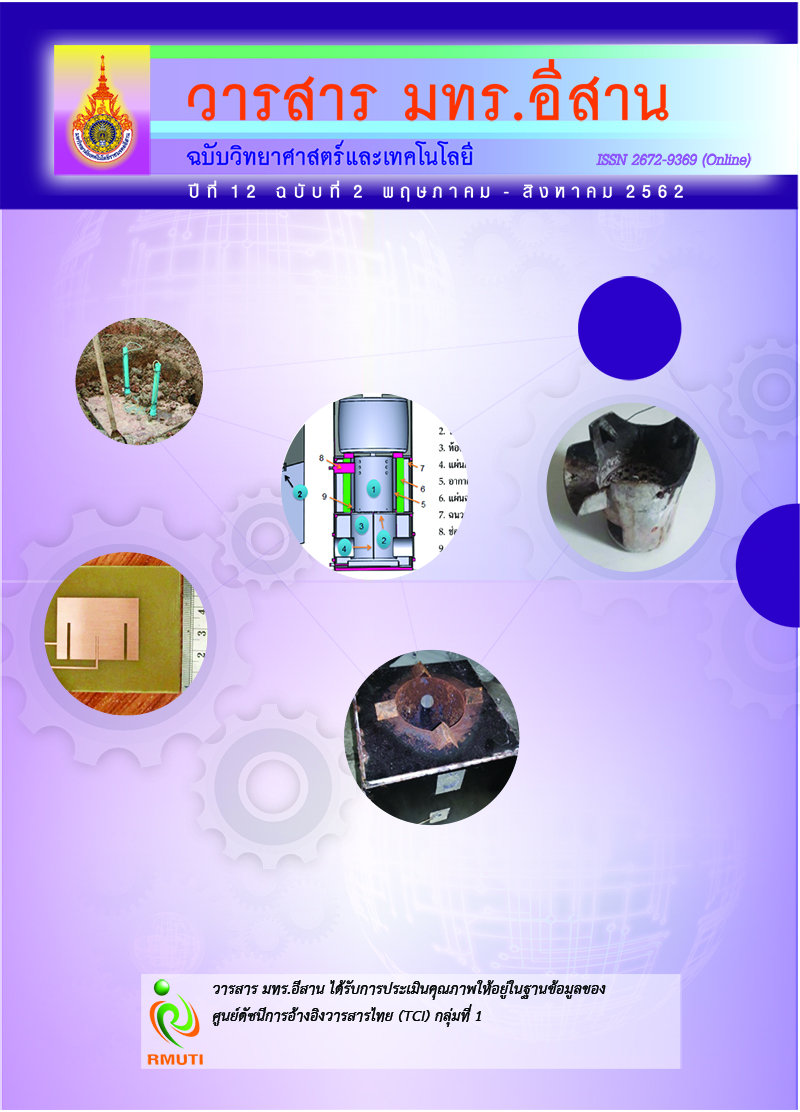ผลของไฮโดรคอลลอยด์ต่อคุณภาพและความคงตัวของเยลลี่ลูกหยีฮาลาล ระหว่างการเก็บรักษา
Main Article Content
บทคัดย่อ
การพัฒนาผลิตภัณฑ์เยลลี่ลูกหยีฮาลาลในพื้นที่ 3 จังหวัดชายแดนภาคใต้มีความสำคัญต่อความมั่นใจ ของผู้บริโภคมุสลิม การศึกษานี้มีวัตถุประสงค์ศึกษาผลของไฮโดรคอลลอยด์ต่อสมบัติทางกายภาพและเคมี และความคงตัวของเยลลี่ลูกหยีระหว่างการเก็บรักษา ทำการเติมคาราจีแนนและเพกทินทดแทนเจลาติน ร้อยละ 0 50 และ 100 พบว่า การทดแทนเจลาตินด้วยคาราจีแนนที่ระดับร้อยละ 50 ตัวอย่างได้รับคะแนน ความชอบโดยรวมมากที่สุด คือ 7.70 (ความชอบระดับปานกลาง) ผลิตภัณฑ์ที่ได้มีค่าวอเตอร์แอคทีวิตี้ (Water Activity: aw) และค่าพีเอชเท่ากับ 0.84 และ 4.05 การประเมินอายุการเก็บรักษาสามารถบรรจุในถุงอลูมิเนียมฟอยล์ลามิเนตที่อุณหภูมิ 4 องศาเซลเซียส นาน 8 สัปดาห์ โดยมีปริมาณเชื้อจุลินทรีย์ ทั้งหมดไม่เกินตามที่มาตรฐานกำหนด 1 x 104 โคโลนีต่อกรัม ซึ่งให้ผลการทดสอบทางประสาทสัมผัส ด้านความชอบโดยรวมที่ระดับคะแนน 6.81 (ความชอบระดับเล็กน้อย) จากผลการทดลองคาราจีแนน ร้อยละ 50 และเจลาตินร้อยละ 50 สามารถใช้เป็นส่วนประกอบสำหรับการผลิตเยลลี่ลูกหยีฮาลาล
Article Details
เอกสารอ้างอิง
[2] Batu, A., Regenstein, J. M., and Dogan, I. S. (2015). Gelatin Issues in Halal Food Processing for Muslim Societies. Electronic Turkish Studies. Vol. 10, Issue 14, pp. 37-51. DOI: 10.7827/TurkishStudies.8928
[3] Adepoju, O. T. (2009). Proximate Composition and Micronutrient Potentials of Three Locally Available Wild Fruits in Nigeria. African Journal of Agricultural Research. Vol. 4, Issue 9,
pp. 887-892
[4] Chedoloh, R. (2018). Study on Post-Harvest Management of Fresh Black Velvet Tamarind and Dehydrating Methods on the Properties and Sensory Evaluation of Pre-processed Product. RMUTSV Research Journal. Vol. 10, No. 1, pp. 52-64 (in Thai)
[5] Ofosu, D. O., Opata, N. S., Gyampo, O., and Odamtten, G. T. (2013). Determination of the Elemental Composition of the Pulp, Seed and Fruit Coat of Black Velvet Tamarind (Dialium guineense) Using Instrumental Neutron Activation Analysis. Research Journal of Applied Sciences Engineering and Technology. Vol. 6, Issue 19, pp. 3536-3539. DOI: 10.19026/rjaset.6.3557
[6] Chedoloh, R., Niseng, Z., and Yoush, H. (2018). Development of Production Processes and Products to Increase Value Velvet Tamarind in Three Southern Border Provinces.
Bangkok, Thailand : The Thailand Research Fund. (in Thai)
[7] AOAC. (2000). Official Methods of Analysis of the Association of Official Analytical Chemists. 15th edition. Virginia: Association of Official Analytical Chemists
[8] Meilgaard, M., Civille, G. V., and Carr, B. T. (1999). Sensory Evaluation Techniques. 3rd edition. New York: CRC
[9] Teodorowicz, M., Neerven, J. V., and Savelkoul, H. (2017). Food Processing: The Influence of the Maillard Reaction on Immunogenicity and Allergenicity of Food Proteins. Nutrients.
Vol. 9, pp. 835-853. DOI: 10.3390/nu9080835
[10] Rattanapanone, N. (2002). Food Chemistry. 1st edition. Bangkok, Thailand: Odean Store
[11] Sunta, R. (2008). Development of Longon Chewy Candy Formulation. Ms. Food Science and Technology Department of Food Engineering, Graduate School Chiang Mai University. (in Thai)
[12] Lasztity, R. (2009). Food Quality and Standard. Oxford, United Kingdon, Vol. 1
[13] Nopchinda, S. (2014). Probiotics for Health Promotion. Journal of The Royal Thai Army Nurses. Vol. 15, Issue 3, pp. 430-435
[14] Supamiyotin, P. (2013). Fruit and Vegetable Technology. Bangkok, Thailand: Odean Store
[15] Sirisee, U. (2009). Substitution of Gums in Mulberry Jelly Part I: Application of Carrageenan to Replace Gelatin in Mulberry Jelly. Department of Food Science and Technology, Faculty of Science and Technology, Rajamangala University of Technology Tawan-ok (in Thai)
[16] Sato, M. F., Rigoni, D. C., Canteri, M. H. G., Petkowicz, C. L. O., Nogueira., A., and Wosiacki., G. (2011). Chemical and Instrumental Characterization of Pectin from Dried Pomace of Eleven Apple Cultivars. Acta Scientiarum Agronomy. Vol. 33, No. 3, pp. 383-389. DOI: 10.4025/actasciagron.v33i3.7125
[17] Sundarraj, A. A. and Ranganathan, T. V. (2017). A Review - Pectin from Agro and Industrial Waste. International Journal of Applied Environmental Sciences. Vol. 12, Number 10,
pp. 1777-1801
[18] Silva, R. S. G., Bandeira, S. F., and Pinto, L. A. A. (2017). Characteristics and Chemical Composition of Skins Gelatin from Cobia (Rachycentron canadum). LWT - Food Science and
Technology. Vol. 57, Issue 2, pp. 580-585. DOI: 10.1016/j.lwt.2014.02.026
[19] Webber, V., Carvalho, S. M. D., Ogliari, P. J., Hayashi, L., and Barreto, P. L. M. (2012). Optimization of the Extraction of Carrageenan from Kappaphycus alvarezii Using Response
Surface Methodology. Ciência e Tecnologia de Alimentos. Vol. 32, Issue 4, pp. 812-818. DOI: 10.1590/S0101-20612012005000111
[20] Thai Industrial Standards Institute. (2004). Thai Community Products Standards 519/2547: Soft Jelly. Bangkok, Thailand: TISI, Ministry of Industry. (in Thai)
[21] Dipiyoti, S. and Suvendu, B. (2010). Hydrocolloid as Thickening and Gelling Agent in Food: a Critical Review. Journal of Food Science and Technology. Vol. 47, Issue 6, pp. 587-597. DOI: 10.1007/s13197-010-0162-6
[22] Thai Industrial Standards Institute. (2004). Thai Community Products Standards 519/2547: Soft Jelly. Bangkok, Thailand: TISI, Ministry of Industry. (in Thai)
[23] Pye, J. (1997). Gelatin and Applications, pp 28-40. In S. Maneepan, ed. Symposium on Confectionery Technology. Food Science and Technology Association of Thailand. Bangkok,
Thailand. (in Thai)


